SWOT Analysis Examples With Templates [Detailed List]
Developing a thorough business or product strategy takes time, but doing so is essential to creating a winning team vision. Planning how to transform your product ideas into workable solutions that clients adore requires careful consideration of some crucial factors. Templates for strategic planning facilitate and organize this process. Business executives and product managers frequently utilize SWOT analysis examples to understand the internal and external factors influencing their success comprehensively.
As your company grows, this framework can assist you in creating a strategy to identify your top goals, seize opportunities, and remove obstacles. Therefore, this article will see different SWOT analysis examples and their uses in various fields.
What is a SWOT Analysis?
Before jumping onto discussing different kinds of SWOT analysis examples, let us first see what is a SWOT analysis. A SWOT analysis identifies the opportunities, threats, weaknesses, and strengths of your business or projects.
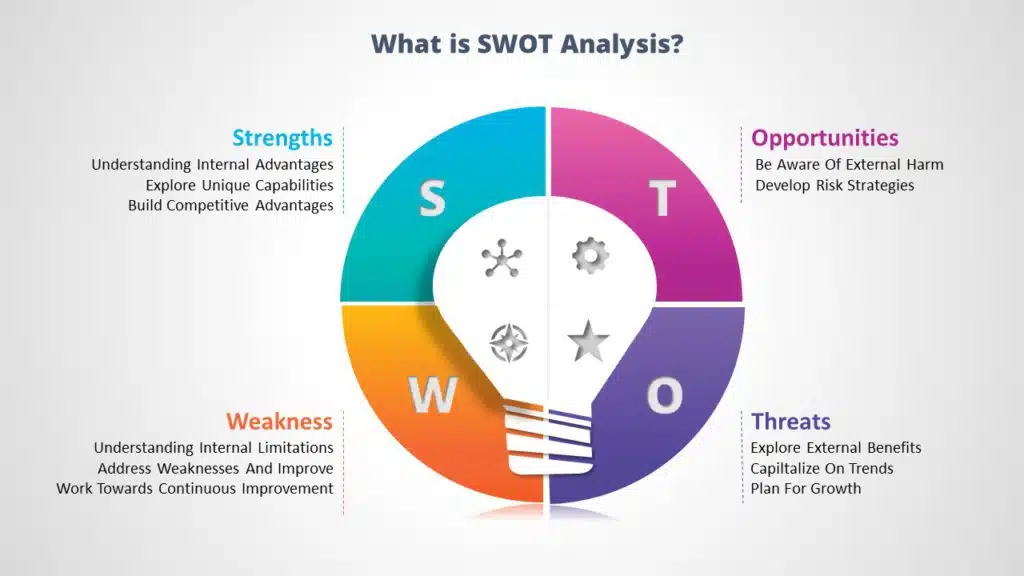
Despite its simplicity, a SWOT analysis is a valuable technique for assisting you in locating areas of competition where you may make improvements. It keeps you ahead of industry trends and helps you develop your team and business.
SWOT analysis is a straightforward and helpful evaluation model. A SWOT diagram evaluates strengths and weaknesses in addition to examining a variety of internal and external aspects. In addition, this combination of evaluation measures helps obtain a comprehensive understanding of a company, product, brand, or new project early in the project life cycle.
Let’s examine each of these concepts in more detail and see how you can use them to pinpoint areas that need work.
1. Strengths
Strengths are internal efforts that are operating at a high level of performance. By looking at these areas, you can learn what is already effective. Then, you can apply your strengths—the strategies you know work—to other areas that might require more assistance, including increasing the productivity of your staff.
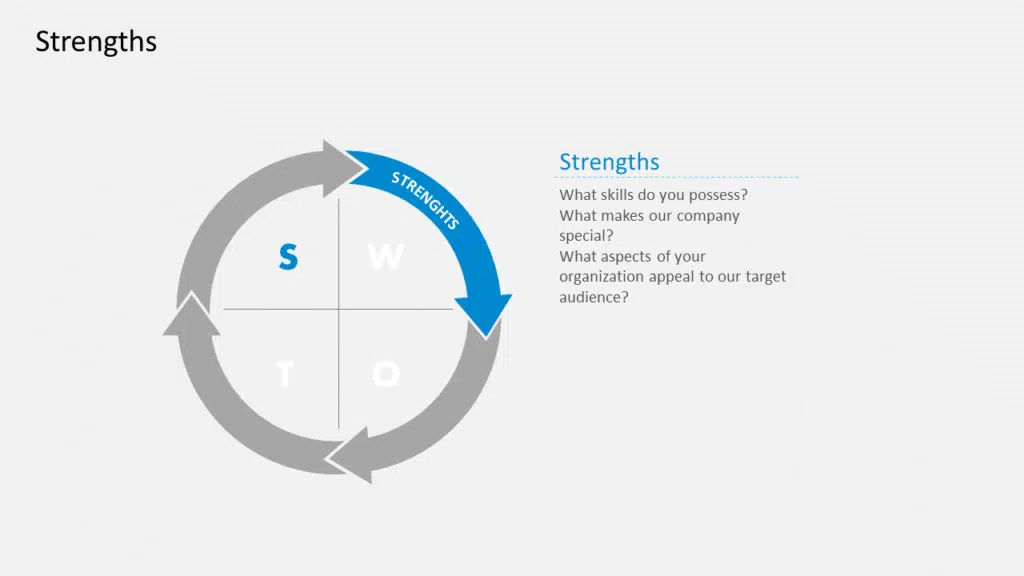
Consider the following inquiries when you assess your organization’s strengths:
- What skills do you possess? What makes our company special?
- What aspects of your organization appeal to our target audience?
- Which features or categories outperform those of our rivals?
2. Weaknesses
Underperforming internal initiatives are referred to as weaknesses in the SWOT analysis. To set a benchmark for success and failure, assessing your strengths before your flaws is a good idea. The first step in making those initiatives better is to identify internal shortcomings.
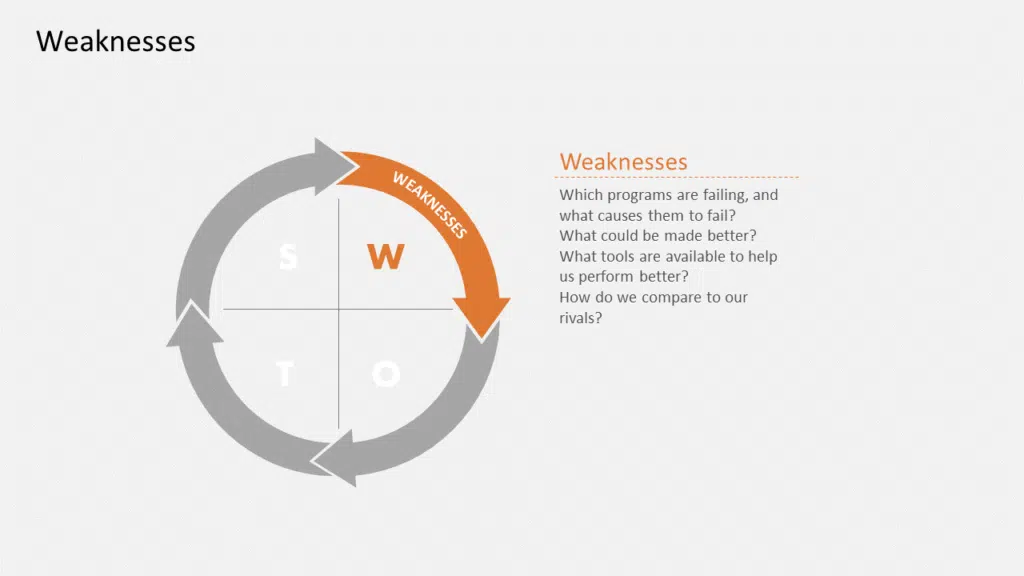
Determine the company’s weaknesses by the following SWOT analysis examples:
- Which programs are failing, and what causes them to fail?
- What could be made better?
- What tools are available to help us perform better?
- How do we compare to our rivals?
3. Opportunities
Your current SWOT analysis opportunities come from your strengths and weaknesses and any outside activities that will improve your competitiveness. These might be anything from regions that weren’t found in the first two stages of your study to weaknesses that you’d like to strengthen.
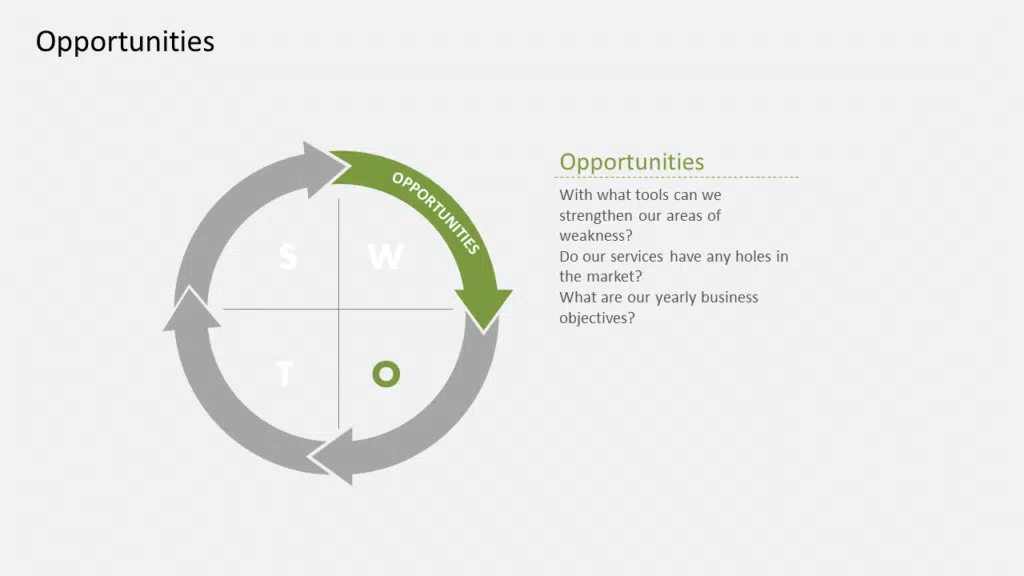
Since opportunities might arise in a variety of ways, it’s beneficial to think about the following queries before beginning:
- With what tools can we strengthen our areas of weakness?
- Do our services have any holes in the market?
- What are our yearly business objectives?
- What services do your rivals provide?
4. Threats
In a SWOT analysis, threats are potential sources of trouble. Threats, as opposed to vulnerabilities, are external and uncontrollable. It can involve anything from a shift in the competitive environment to a worldwide pandemic.
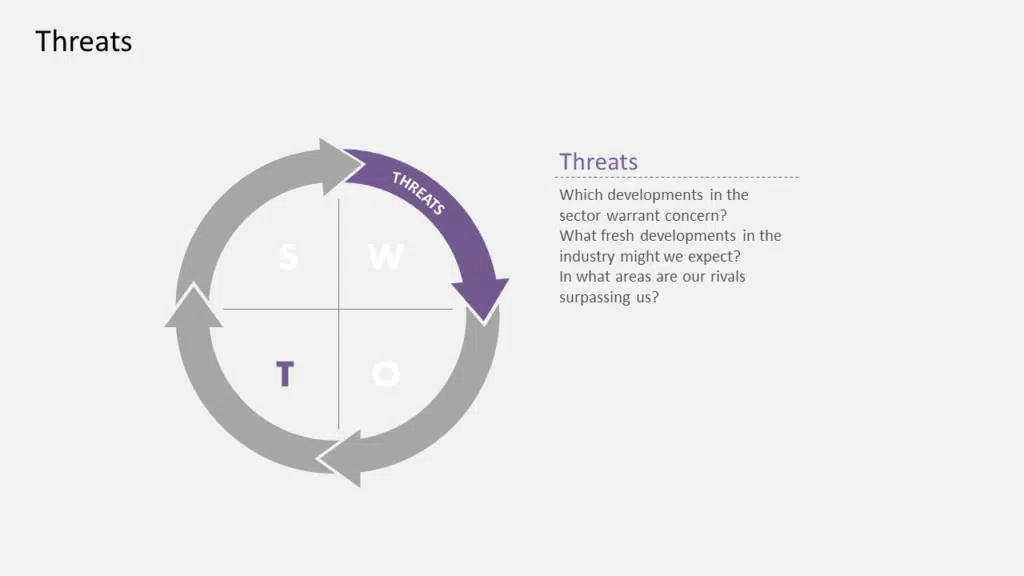
To recognize external risks, ask yourself the following questions:
- Which developments in the sector warrant concern?
- What fresh developments in the industry might we expect?
- In what areas are our rivals surpassing us?
Examples of Different Types Of SWOT Analysis
Now that you know what is a SWOT analysis let us see different SWOT analysis examples to understand how you can use them in your business and different scenarios:
1. Personal SWOT Examples
One of the first examples is a personal SWOT analysis. It helps examine oneself using a well-known structure. SWOT analysis lets you determine your opportunities, weaknesses, and strengths.
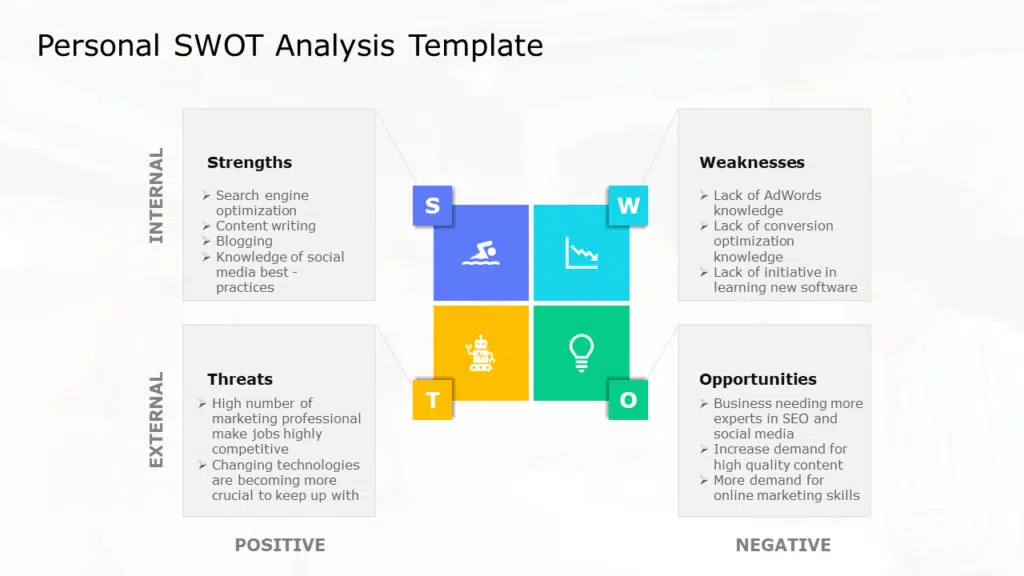
A personal SWOT analysis could be helpful to evaluate your progress in some circumstances. For example, you wish to change careers or advance in your current industry. It would be best to approach “threats” in your own SWOT analysis from a different perspective.
You can find areas where you might improve by directly comparing your strengths and weaknesses, as seen in these SWOT examples.
2. SWOT Analysis Examples for Business
Swot analysis examples for business can help you pinpoint your company’s present advantages and draft a successful long-term strategy. SWOT analysis can also highlight areas of your business operating poorly or that your competitors may take advantage of if you don’t protect them.
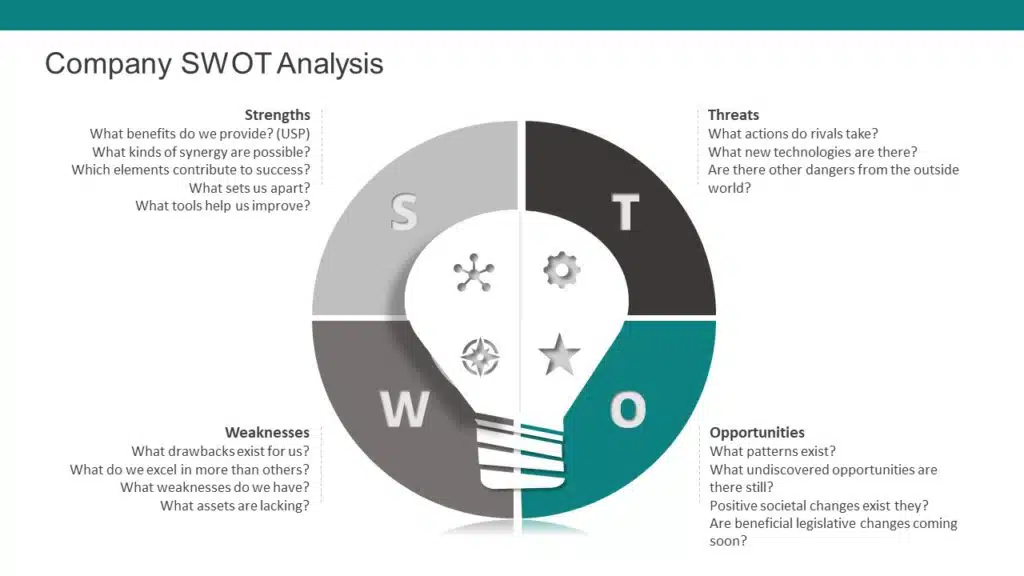
A SWOT analysis examines internal and external problems in your organization. As such, you will have control over some of these variables but not all. Once you’ve recorded, identified, and investigated every possible variable in each case, your best action plan will become more apparent.
3. SWOT Analysis For Projects
SWOT analysis examples for projects are established to assess each high-value, complicated strengths, weaknesses, opportunities, and threats of a project. A SWOT analysis identifies the elements supporting or restricting the project’s development. Before a project starts, you can prepare to monitor and control key controllable aspects to make sure the project meets its goals. You can do this by outlining potential risks.
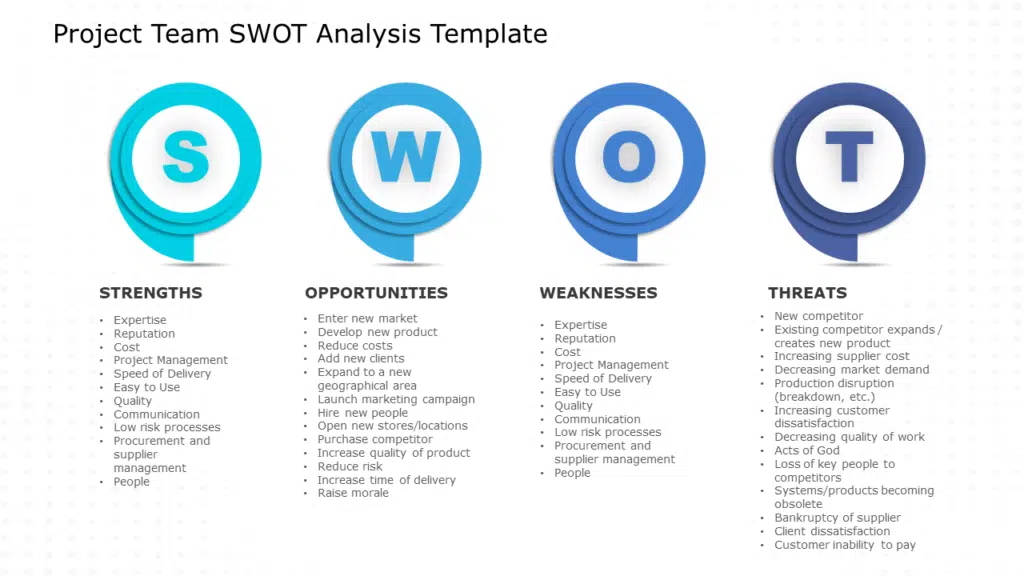
Another compelling reason to do a SWOT analysis is to understand the factors that can help you create an effective, Responsible, Accountable, Consulted, and Informed (RACI) matrix so you have the right people supporting the project at every step.
Conducting a SWOT analysis for project management is similar to performing it to determine overall strategy. Essentially, you’ll want to assemble a group and analyze the strengths, weaknesses, opportunities, and threats associated with any potential projects that leaders or team members suggested. For each project, discuss the following:
Strengths: What internal factors will set this project up for success?
Weaknesses: What internal weaknesses may hinder the success of this project or make it challenging to complete?
Opportunities: Are there external opportunities you should take advantage of about the project, such as current public opinions, monetary discounts from business partners, or something similar?
Threats: Are there external factors, either now or shortly, that could threaten the project’s success, such as rising costs or the exit of key staff members?
4. Examples
Competitive SWOT analysis examples help you understand your opponent’s perspective easily. It forces you to consider the competitor’s company’s internal strengths and weaknesses as well as the opportunities and threats they face in the external market.
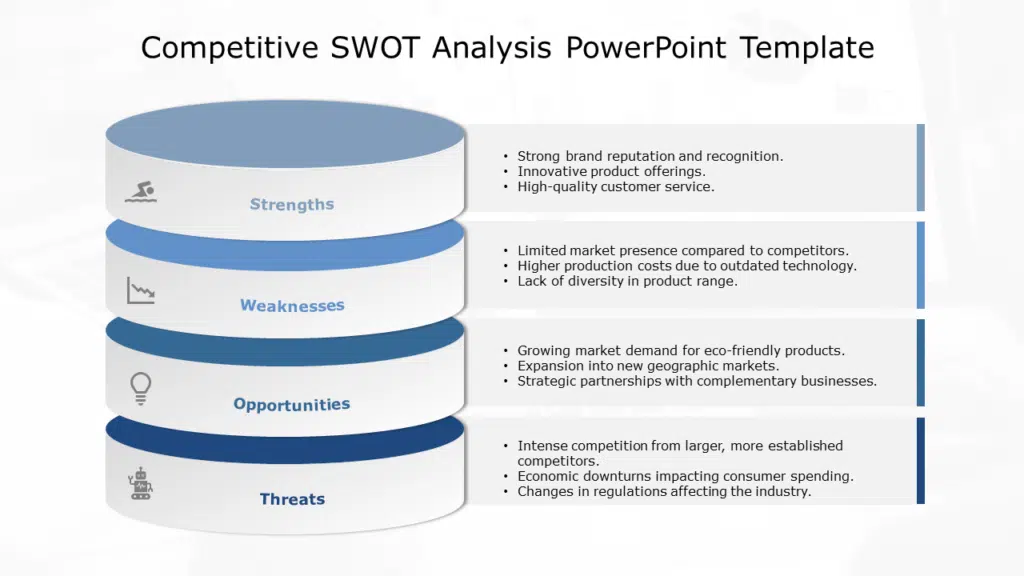
Competitor analysis is crucial and requires meticulous attention to detail. Any successful sales and distribution strategy starts with a thorough understanding of what your competitors are doing, why they are doing it, how they are doing it, what their results are, and why you are different. A SWOT analysis of a competitor is a great way to start understanding where they are right now.
A competitive SWOT analysis contrasts the strengths and weaknesses of an organization with those of its competitors and helps to obtain strategic insights. It supports businesses in determining their competitive advantages, comprehending market dynamics, and creating winning strategies. It aids in making decisions in areas like product development, marketing, and market expansion.
5. Product SWOT Analysis Examples
Product SWOT analysis examples help you honestly evaluate a product from every angle, taking external and internal factors into account to build helpful strategies for teams across the whole business.
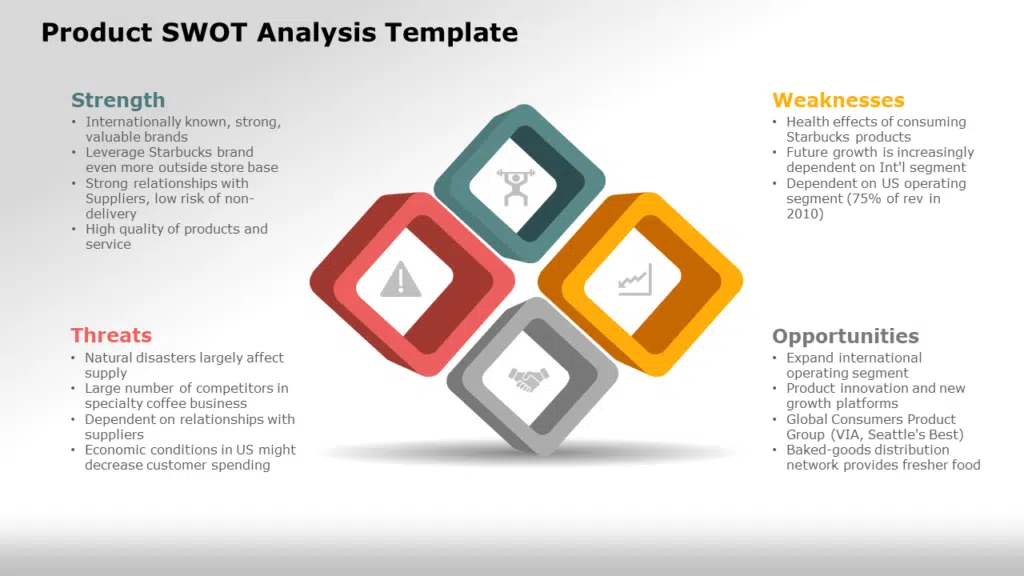
Each section of the SWOT framework can provide valuable strategic insight that you might otherwise miss with your heads kept down. It can surface features you should add to keep pace with market trends and help product teams realize where the wind is blowing.
It can even help find opportunities for new products in your existing portfolio or help cement the use case for one you’ve got in the pipeline. Threats and opportunities, meanwhile, can be the building blocks of your ongoing product roadmap.
6. Environmental SWOT Examples
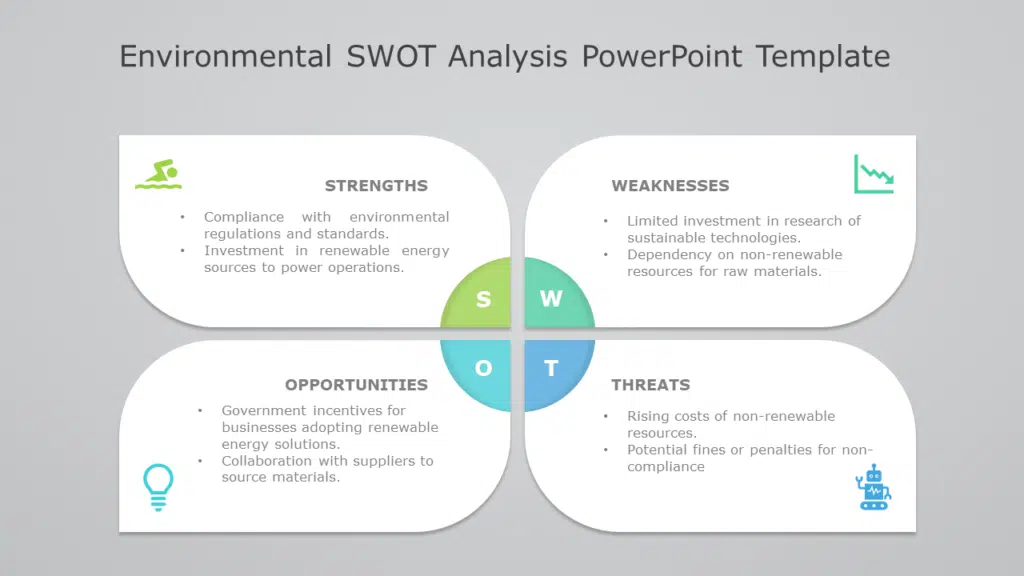
Environmental SWOT analysis helps you decide on the design of the performance management system by identifying internal and external issues. It enables you to gain insight into the state of the industry and the context in which your organization operates. You can get strategies for risk management, adaptability, and strategic planning by environmental SWOT analysis.
7. Strategic SWOT Analysis Examples
Strategic SWOT analysis examples compare and contrast internal and external opportunities and threats to guide long-term strategic planning. Businesses can leverage their advantages and reduce any possible threats by doing so. Strategic SWOT analysis assists organizations in matching their strengths with strategic objectives by concentrating on long-term planning and decision-making.
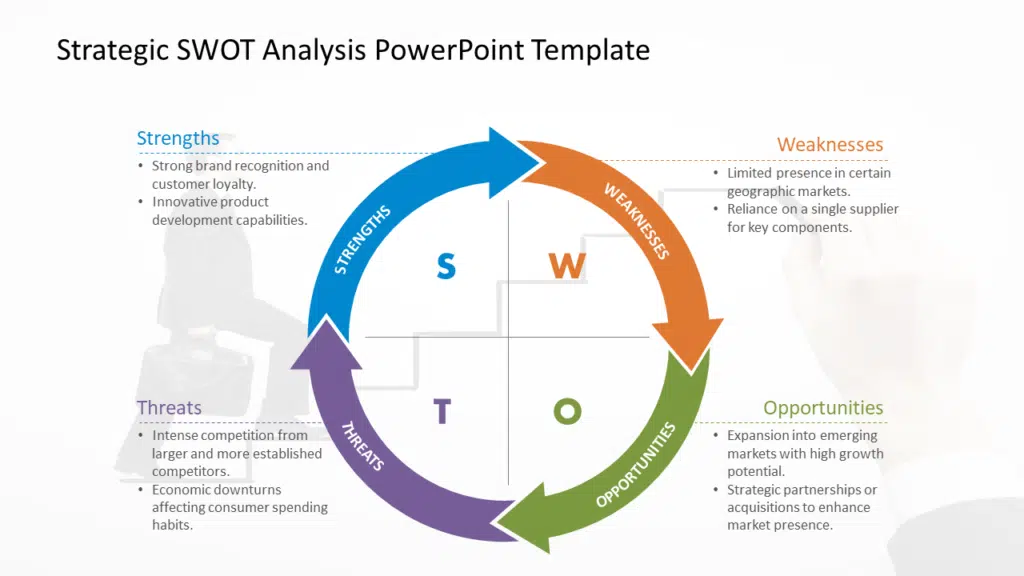
It supports businesses in determining their strategic priorities, allocating resources wisely, and building long-term competitive advantage. Strategic SWOT analysis also helps in decision-making in domains including market expansion, diversification, and innovation.
8. Cultural SWOT Analysis Examples
Cultural SWOT analysis examples assess the performance, innovation, and employee satisfaction effects of an organization’s culture. It supports businesses in addressing cultural issues, maximizing cultural strengths, and creating a productive workplace. It also informs decisions about organizational change projects, employee engagement, and leadership development. With the help of this template, you can determine the following:
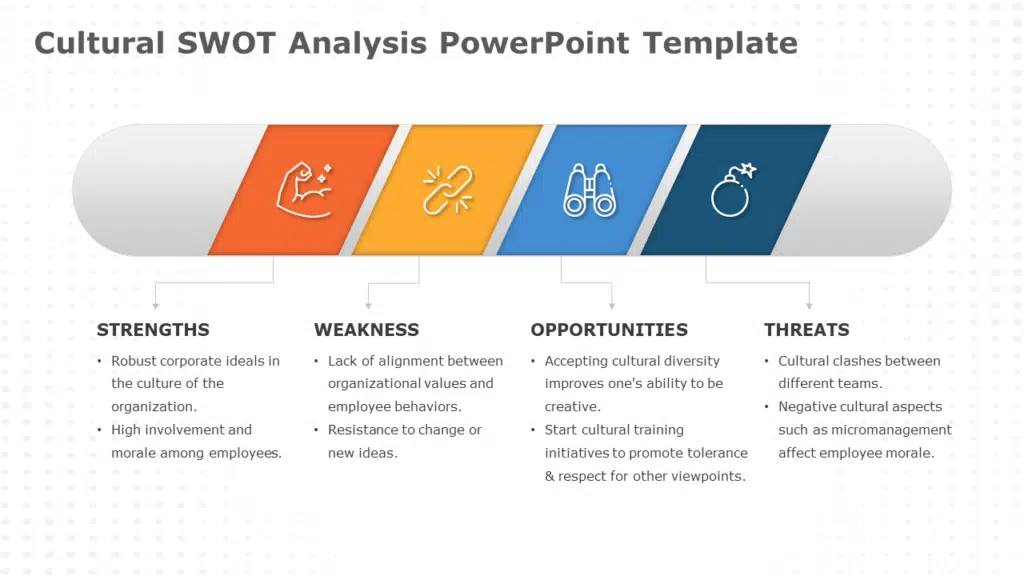
Strengths:
- Robust corporate ideals in the culture of the organization.
- High involvement and morale among employees, creating a happy work atmosphere.
- An innovative and creative work environment with a diverse team representing various backgrounds and viewpoints.
- Channels and practices for effective communication that encourage openness and cooperation.
Weaknesses:
- Lack of alignment between organizational values and employee behaviors.
- Resistance to change or new ideas due to entrenched cultural norms.
- Communication barriers stemming from cultural differences among team members.
- Inconsistencies in enforcing cultural norms across different departments or locations.
Opportunities:
- Accepting cultural diversity improves one’s ability to be creative and solve problems.
- Putting in place cultural training initiatives to promote tolerance and respect for other viewpoints.
- Leveraging cultural characteristics to attract top talent and enhance employee retention.
- Forming alliances with businesses that hold comparable cultural values to increase market penetration.
Threats:
- Cultural clashes between different departments or teams hinder collaboration and productivity.
- Negative cultural aspects such as micromanagement or lack of accountability affect employee morale.
- Difficulty in retaining diverse talent due to cultural insensitivity or bias.
- External factors such as mergers or acquisitions lead to cultural integration challenges.
9. Technology SWOT Analysis Examples
Technology SWOT analysis examples drive solutions for your products. Once you design products and services that meet your customers’ needs, you must know how to evolve with them to make the product/service up to the mark, and a technology SWOT analysis is precisely for that.
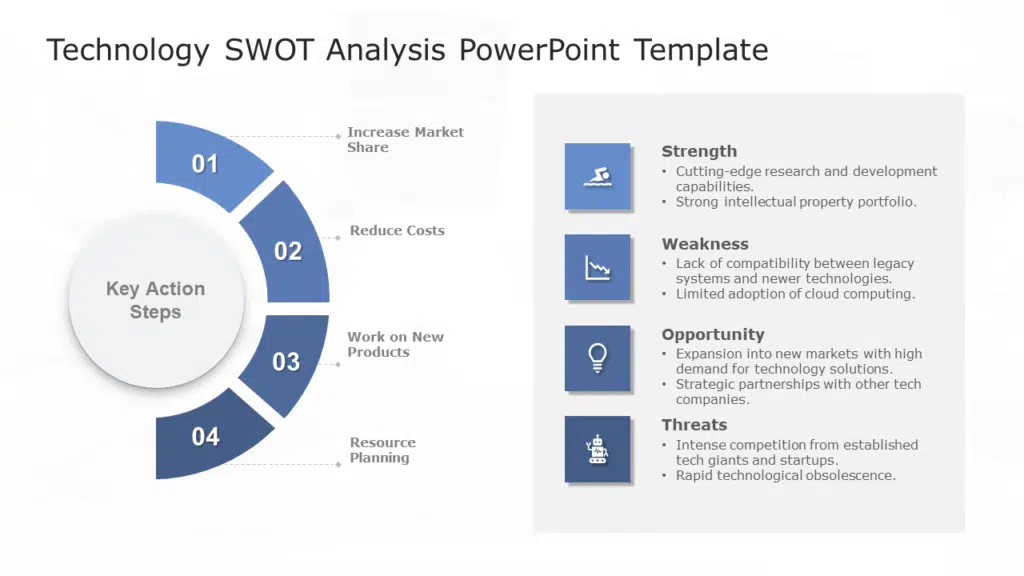
Anticipating the future requires knowing the context in which you operate, including your internal and external clients, what they need from you, how you can better serve them, and how you stack up against other technology leaders in your industry. SWOT analysis is a valuable tool for developing this comprehensive image.
Functional business sectors like information technology can use a SWOT analysis for multiple purposes; it is a valuable tool for developing a product’s comprehensive image.
10. SWOT Analysis Examples For Customers
Businesses can improve customer happiness and loyalty by using customer SWOT analysis examples. It helps better understand consumer preferences, behaviors, and expectations. It assists companies with determining the demands of their clients, resolving issues, and setting themselves apart from competitors.
A Customer SWOT analysis informs decisions on product design, marketing strategy, and customer service enhancement. You can determine the following factors:
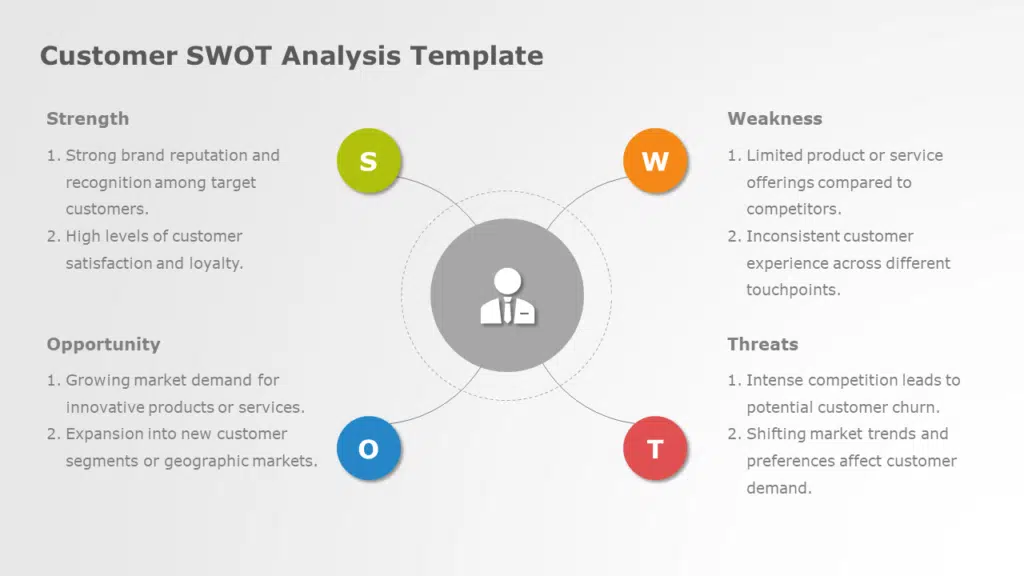
Strengths
- Strong brand reputation and recognition among target customers.
- High levels of customer satisfaction and loyalty.
- Comprehensive understanding of customer preferences and buying behavior.
- Robust customer service and support systems in place.
Weaknesses
- Limited product or service offerings compared to competitors.
- Inconsistent customer experience across different touchpoints.
- Challenges in effectively addressing customer complaints and feedback.
- Lack of personalized marketing strategies tailored to individual customer segments.
Opportunities
- Growing market demand for innovative products or services.
- Expansion into new customer segments or geographic markets.
- Leveraging technology to enhance customer engagement and communication.
- Collaborating with complementary businesses to offer bundled solutions.
Threats
- Intense competition leads to potential customer churn.
- Shifting market trends and preferences affect customer demand.
- Adverse publicity or customer reviews impact brand reputation.
- Regulatory changes or economic downturns affect customer purchasing power.
11. Financial Analysis
Financial SWOT analysis examples help you assess the following things:
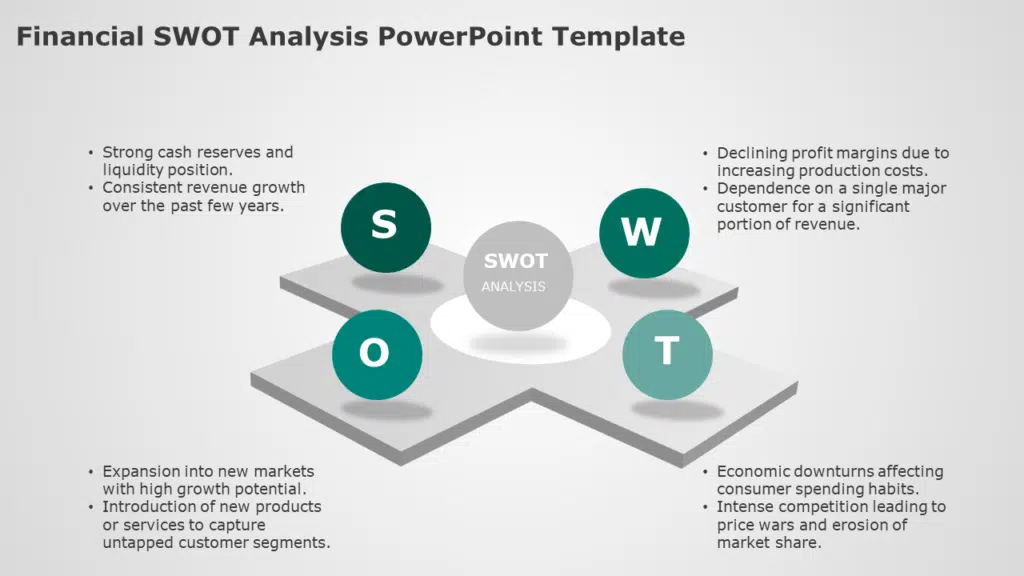
Financial Strengths
You can make a list of your strengths before starting your SWOT analysis. Think of everything that improves your present financial condition or gets you closer to your financial objectives. Enumerate all of the assets and skills you have at your disposal to gain a competitive edge. Add your offerings of goods and services and any intangibles, human capital, and unique talents you may have.
Include any unique qualities to your market and everything you have to offer that your rivals don’t. Think about these advantages and consider how you can best leverage them to provide you with a competitive advantage.
Assess Your Financial Weaknesses
List the internal financial factors that prevent you from competing at the same level as your rivals, such as debt, a lack of income, or cash shortages. Compared to other people in your business, you can find the shortcomings. You can even consider it a weakness if you lack some of your strengths. You can strengthen your future financial status by identifying and addressing the areas where you are weak.
Assess Financial Opportunities
Make another list of opportunities—achievable steps you haven’t yet done or utilized to the fullest. In terms of money, these changes can be investments, income, debt payoff, or interest savings. Incorporate any potential supplier discounts, equipment purchases, or encouraging market trends.
When you truly consider all the possible paths you could take with your finances, you can nearly always find chances, even if they are first tricky. But you shouldn’t always go for the most profitable possibility. You can have a better chance of success by using your strengths to pursue the best fit.
Assess Financial Threats
Lastly, list every danger or element posing a risk to your company’s finances. These are outside factors that you might not always be able to control.
Think about the things that your rivals do better. Do they have a broader range of products, better customer service, or cheaper prices? Ascertain which ones are most dangerous for you or your company, then devise strategies to counter them. Instead of attempting to stop every threat, try reducing as many of these risks as possible.
12. Industry SWOT Analysis Example
Industry SWOT analysis examples help assess the macroeconomic conditions, legal frameworks, and technological developments that affect an industry. A SWOT study of an industry could look at things like legislative changes, technological disruptions, market growth, and the level of competition.
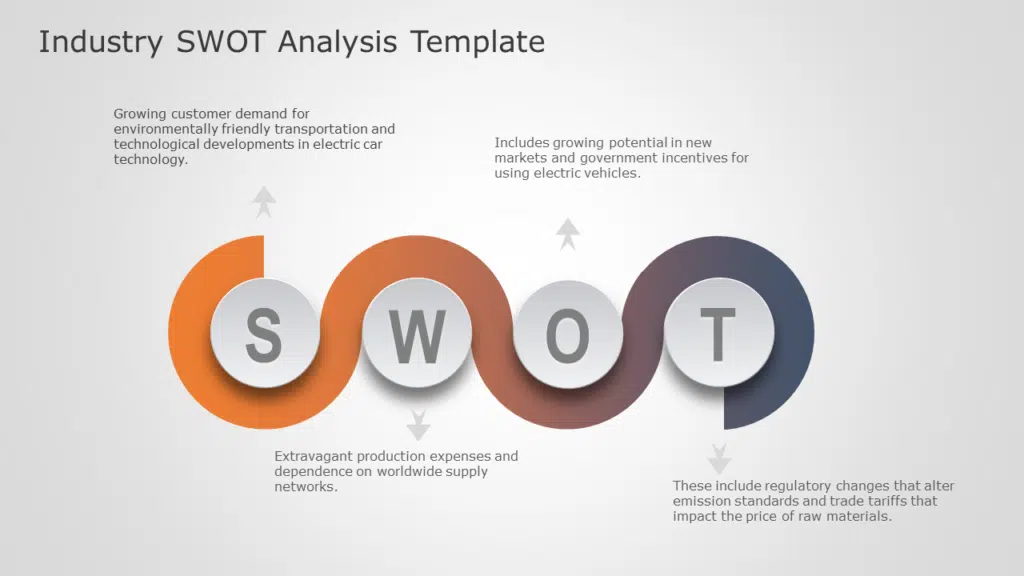
- Strengths: Growing customer demand for environmentally friendly transportation and technological developments in electric car technology.
- Weaknesses: Extravagant production expenses and dependence on worldwide supply networks.
- Opportunities: Includes growing potential in new markets and government incentives for using electric vehicles.
- Threats: These include regulatory changes that alter emission standards and trade tariffs that impact the price of raw materials.
13. Cross-Functional SWOT Analysis Example
Cross-functional SWOT analysis examples require cooperation between departments or teams to obtain a variety of viewpoints and insights. It aids in the identification of dependencies and the alignment of strategic priorities within the company.
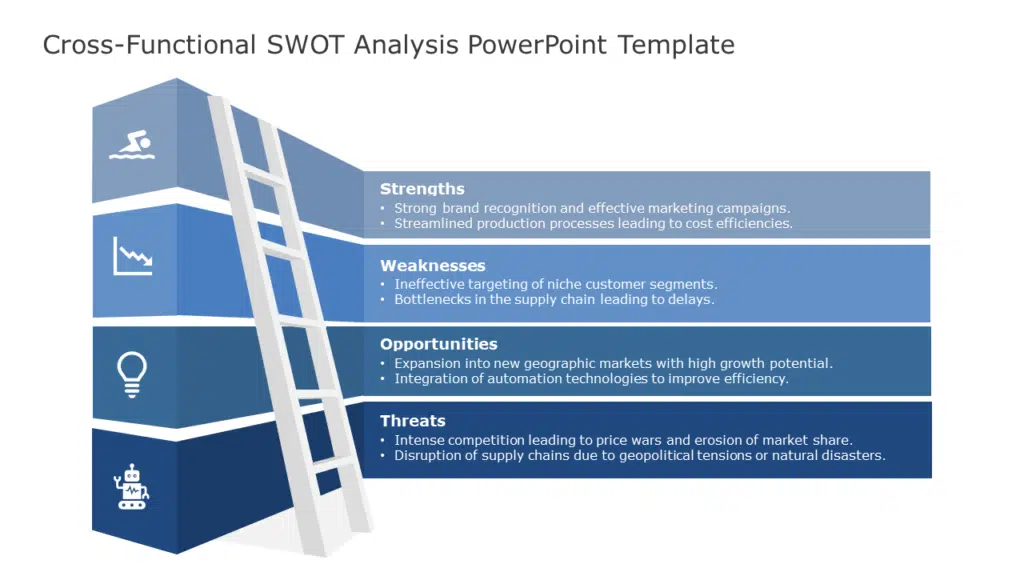
It helps in Decision-making in domains like product creation, market expansion, and organizational development. Using SlideUpLift’s cross-functional SWOT analysis template, you can identify the particular strengths, weaknesses, opportunities, and threats accordingly.
Strengths
- Effective routes for departmental communication.
- Multiple points of view and proficiencies from multidisciplinary groups.
- Streamlined decision-making procedures by working together.
Weaknesses
- Information gaps and a need for more openness among departments.
- Opposition to departing from the established departmental frameworks.
- Goals and priorities need to align across functions consistently.
Opportunities
- Utilizing a combination of resources to develop new ideas and products.
- Enhancing client satisfaction with integrated services and solutions.
- Boosting morale and employee engagement through cross-functional initiatives.
Threats
- Conflict brought on by different departmental goals.
- Delays in project schedules are a result of communication problems.
- Inefficiencies resulting from unaligned goals.
14. Global SWOT Analysis
Global SWOT analysis examples look at worldwide economic trends, international marketplaces, and geopolitical variables to find opportunities and threats on a global level. It supports businesses in strategically growing their international footprint and navigating the complexities of a globalized world.
International trade policy, global supply chain management, and market entry strategies are just a few domains where global SWOT analysis helps make decisions.
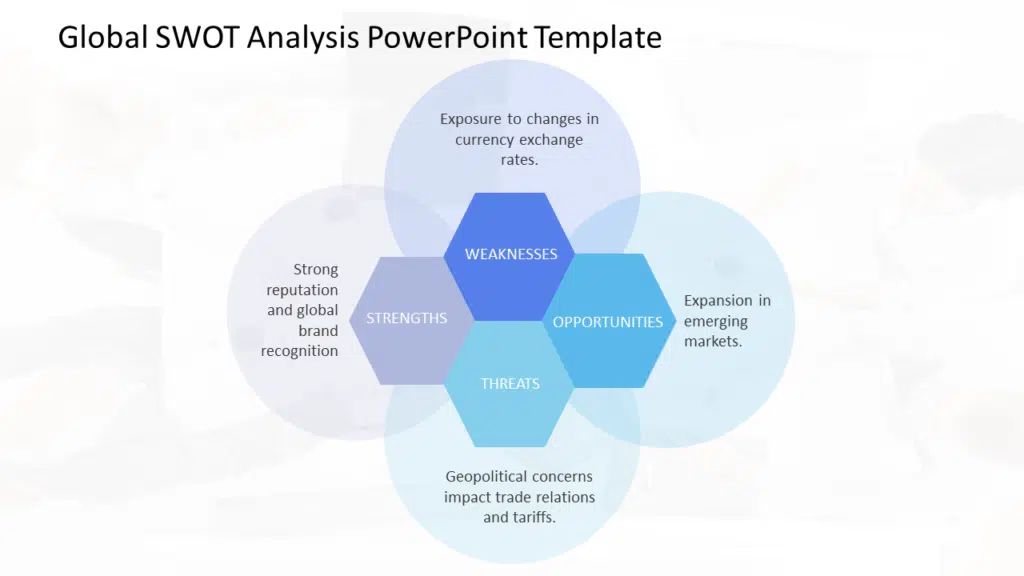
Strengths
- Strong reputation and global brand recognition.
- Vast international networks for distribution and market presence.
- Leadership in technological innovation within the industry.
Weaknesses
- Exposure to changes in currency exchange rates.
- Supply chains that rely on several foreign partners.
- Difficulties in complying with various regulatory regimes.
Opportunities
- Expansion in emerging markets.
- Strategic alliances to expand the market with nearby companies.
- Growing need for digital services in underprivileged areas.
Threats
- Geopolitical concerns impact trade relations and tariffs.
- Key markets’ economic volatility has an impact on consumer expenditure.
- Modifications to regulations that impact compliance obligations and data privacy laws.
SWOT Analysis Templates Collection
This collection provides you with more than 15 slides with different designs. All the slides are fully editable and are compatible with both MS PowerPoint and Google Slides.
Conclusion
SWOT analysis is a fundamental component of strategic planning that provides information on an organization’s possibilities, threats, and internal and external strengths and weaknesses. We discussed various SWOT analysis examples, covering project management, corporate strategy, and personal growth. We demonstrated how to organize these studies efficiently by utilizing SlideUpLift’s PowerPoint templates, providing a road map for well-informed decision-making and plan building. The extensive library of SWOT analysis templates on SlideUpLift is a success accelerator, helping teams, businesses, and individuals overcome obstacles and seize chances.
FAQs
-
What is an example SWOT analysis?
A SWOT analysis example demonstrates a business or project’s strengths, weaknesses, opportunities, and threats, aiding in strategic decision-making.
-
Does SlideUpLift have a sample SWOT analysis available?
Yes, we offer sample SWOT analysis templates to help you structure your assessment effectively based on your organization’s context and objectives.
-
Can you provide some SWOT analysis opportunities examples?
SWOT analysis opportunities examples include identifying emerging market trends, expanding into new regions, leveraging technology, and forming strategic partnerships.
-
How to find SWOT examples for businesses?
SlideULift offers SWOT examples tailored for businesses across different sectors, covering aspects such as market positioning, competition, operations, and strategy.
-
What are some swot analysis of a company example?
swot analysis of a company example evaluates its strengths, weaknesses, opportunities, and threats, providing insights into its strategic position and potential challenges.




















